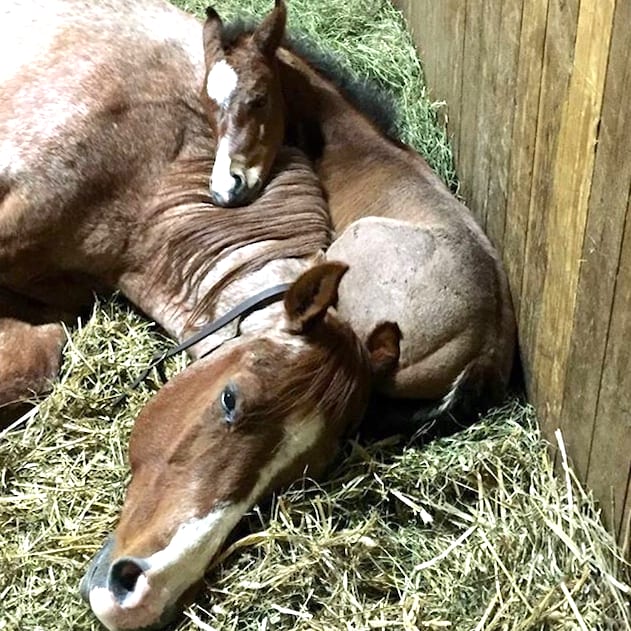Nothing brightens the day like the photos of newborn foals peeking around their moms at the camera. This time of year is the best for foal watching, whether you’re on social media or if you’re lucky enough to be the friend of an owner whose mare is in foal.
The same way the web is filled with photos of precious foals discovering their new world, it is also filled with an abundance of perhaps confusing information for mare owners on preparation for the upcoming birth.
GoHorseShow.com wanted the straight scoop on what today’s top breeders really keep in their foaling kits, and what they have found to be good practices to follow. While each breeding manager has his or her favorite tools, their advice on the basics for a strong, healthy foal shares the same common threads.
 Mike Hay, Breeding Manager
Mike Hay, Breeding Manager
Pilot Knob Quarter Horses
Mike’s standard for foaling prediction
I have my four foaling stalls equipped with cameras that are received at my house (800 feet away). This is what works best for me dealing with several at a time.
The Foaling Kit Elements
My basic foaling cart includes, rubber gloves, towels, navel iodine, scissors, OB sleeves, trash bags (for placenta disposal) and large cable ties (to tie up afterbirth until mare cleans). We keep this cart stocked at all times and just roll the cart to the stall where it’s needed.
Although in my experience nature will take care of 80% of the process, it’s the other 20% that I try to be prepared for. I use a refractometer to measure the colostrum quality. I would not be without this as it’s easy to use and takes the guess work out of it. I keep a bank of frozen colostrum to supplement any foal that may need it. I also keep Banamine to manage the mare’s pain if needed and pull ropes ready to go if needed.
Other steps to take before foaling
If I was to recommend anything to a novice mare owner is as the due date approaches if your mare does not have udder development to speak to your vet and get a plan in place ahead of time for a colostrum supplement and or plasma for the foal. A little planning for this can save an emergency at foaling.
 Debbi Trubee, Breeding Manager
Debbi Trubee, Breeding Manager
Pine View Farm
Debbi’s advice for foaling prediction
We use Predict A Foal testing kits here. They are simple to read and are very dependable. You can also use pool strips for testing calcium and PH level in the mare’s milk. Testing the milk and watching for physical changes in the mare’s vulva and relaxing of the muscles over her hip and tail head are also good indicators of imminent foaling. Waxing of the teats is a final sign however not all mares wax prior to foaling. If your mare is spraying milk, she’s going to have a baby soon!
We use cameras to watch our mares that are preparing to foal. The cameras are manned all night long and we can check on the girls throughout the day via our phones. Foal alarms can also be sewn in a mare’s vulva with a signal being sent to multiple phones should the magnet break indicating a foaling in progress.
Most births are uneventful however having someone in attendance is crucial should there be a problem with presentation of the foal. Most malpresentations of a foal can be easily corrected in a lot of cases if someone is in attendance. A severe dystocia will require more skill so have your vet’s number on speed dial or someone who can help talk you through a foaling issue. Time is of the essence with a severe problem.
The Foaling Kit Elements
Your foaling kit should consist of towels for drying the baby, enema to be sure the baby passes the meconium, latex gloves, umbilical clamp, clean sharp scissors, rarely do we have to cut an umbilical cord, but just in case, we keep these things handy.
We use Novalsan solution diluted 1:1 for spraying the umbilical stump immediately after it breaks and several more times after the foal arrives. Iodine tends to dry the skin too fast and cause cracks that bacteria can enter.
Our mares are wormed with Ivermectin immediately after foaling. Having Banamine for pain on hand as well as a sedative for the mare such as Rompun along with needles and syringes is necessary should the mare become extremely painful after delivery. The placenta will need tied up after foaling either by knotting it or binding it up with string. If your mare doesn’t pass her placenta within three hours, you need to call your vet!
Other steps to take ahead of time
First time broodmare owners should take the time to watch some videos on YouTube of the foaling process, some mares can be drama queens and for a first time mare owner and this can be frightening.
Learn the time frame windows for each stage of labor and time frame expectations of the foal standing, nursing, and the mare passing her placenta. The most important thing I tell our first time foal owners is to have the vet do an IgG test on the baby within 18 hours of birth. Just because you see the baby nurse does not mean it got enough colostrum from the mare. Doing an IgG test is the only way to know this. (Editor Note: The IgG test is an immunoglobulin test that measures the antibodies that protect against bacterial and viral infections.)
Newborn foals fail rapidly and will die in short order if they do not get enough colostrum from the mare. The expense of trying to save a failure of passive transfer foal is huge once they have started to crash and can be futile if left too long. Catching this early and giving the baby plasma is an easy fix. We run plasma on ever baby born at the farm within 12 hours of birth to give them a good jump start.
 Amy Gumz, Owner & Breeding Manager
Amy Gumz, Owner & Breeding Manager
Gumz Farms
Amy’s advice for foaling prediction
We use the Foal-Alert system and have for 15 years. It’s a great TOOL but does not replace the need for a human. We also have attendants that monitor the foalings.
The Foaling Kit Elements
In our basic foaling kit – we have dry towels, sterile gloves and sleeves, iodine dip for the navel, warmed enema, knife, umbilical clamp and pulling straps. We also have penicillin nearby as we give that to the foals as well after delivery. We do keep tranquilizers and pain medications nearby as well for the mothers as well as oxygen tanks for distressed foals.
Other steps and plans to make ahead
First, good prenatal care of the mare is critical and is important up until foaling. A safe, quiet and dry place to foal that has ample space is very important. Having a vet or person to be able to contact is necessary if there is a situation that needs outside assistance. Watch a few natural foaling videos – know what to expect. So many people want to help and they often cause more harm than good.
Mare owners need to be aware of the time commitment and skill level/knowledge that is required for a safe foaling. If everything goes as planned, Mother Nature often takes care of everything. When it doesn’t go that well – experienced vets or techs are priceless. Also plan on a lot of nights monitoring the mares up until they foal and be prepared for the time commitment. I had a great client put on Facebook that she was much more valuable employee (she was an attorney) being well rested and comfortable knowing her mare was being cared for and that outweighed the benefits of having the mare at home.
 Dewey Smith, Breeding & Farm Manager
Dewey Smith, Breeding & Farm Manager
Prince Farm
Dewey’s advice on foaling prediction
You really want to watch your mare carefully during this time for clear signs such as dripping milk. It’s most important to be there for the foaling, and we foal every baby out in case we have to assist the mare. We use the Foal Alert System so we are sure when the mare is ready to foal.
The Foaling Kit Elements
We include iodine to dip your navel, and we keep dental floss to tie the navel off, scissors in case you have help detach the navel, Fleet enemas, vet wrap, sterile gloves, Banamine with needles and syringes, oxytocin to help the mare drop the afterbirth, and 60cc syringes, as you can cut the bottom out to milk a mare with. We keep an oxygen tank, but we also have 20-25 foals a year, so even though a lot of mare owners won’t have that, but we keep an oxygen mask on hand for the babies in case of emergency.
Other advice for pre-planning
Part of the education of a mare owner is to know how the birth canal is formed, because if you have to assist a mare, you have to pull down so that you can do so according to the birth canal. You should plan on being there to make sure the baby’s nose is clear of debris, as the amniotic fluid can burn their lungs, and to make sure you doctor the naval as soon as cord is broke to cut your chances of infection to minimum.
You also want to make sure you plan to stay with them to be sure the baby is nursing. We run our own IgGS at 12 hours old so we can get a number to make sure the baby is good. The average person at home can’t do that, but there are snap tests you can run form a bit of blood from the baby. Most vet supplies carry a snap test that owners can have on hand.
I think the crucial point is that you need to make sure your baby stands and nurse and you plan on visually watching it. You’re going to have those that need help, and that’s one of the key aspects to getting them through the first 24 hours.
 Chris Arentsen, Owner & Breeding Manager
Chris Arentsen, Owner & Breeding Manager
Arentsen Quarter Horses
Chris’ advice on foaling prediction
Cameras are great but you still have to wake up! We’re big believers in the Foal Alert System, which is a transmitter that we sew into the mare’s vulva. Then we don’t have to stay up all night with them. All you have to have is a phone line and a plug in – it calls your cell phone, and I can connect it with up to four cell phones. They have single use transmitters and we use their multi-use transmitters, which give you two hours of battery life in case the mare itches in the corner and it needs to be reattached. We use this system with all our mares.
The Foaling Kit Elements
We have dry towels and iodine or Nolvasan for their navels, and we also keep plasma on hand. We run an IgG test on the foal’s blood within 24 hours, to make sure their count is not low. If it is too low, we have the plasma on hand. The baby has to get enough colostrum within the first 24 hours to have the proper antibodies, and the test tells us if that vital step has happened. For the small breeder or owner foaling at home, cheaper snap tests to check the antibody levels are available for around $30.
Other steps to take before foaling
Luckily, we haven’t had a lot of foaling problems, but if you’re a small breeder, having your vet on standby would be important. The biggest piece of advice I can offer is to get the baby up and make sure he or she has nursed, and make sure your mare discharges the afterbirth. We give our mares a shot of oxytocin to help them relieve their afterbirth.
About the author: Delores Kuhlwein, a freelance equine writer, shows and breeds American Paint Horses and American Quarter Horses together with her husband, Mark, in Glendale, Arizona. Delores began sharing her lifetime love of horses through writing in 2011 after retiring from 15 years as an educator. In addition to being active with her local regional Paint Horse club and the American Paint Horse Association, she manages two family-owned businesses. Her favorite activities are showing her beloved mare in amateur events, and traveling with her husband and two dogs.









